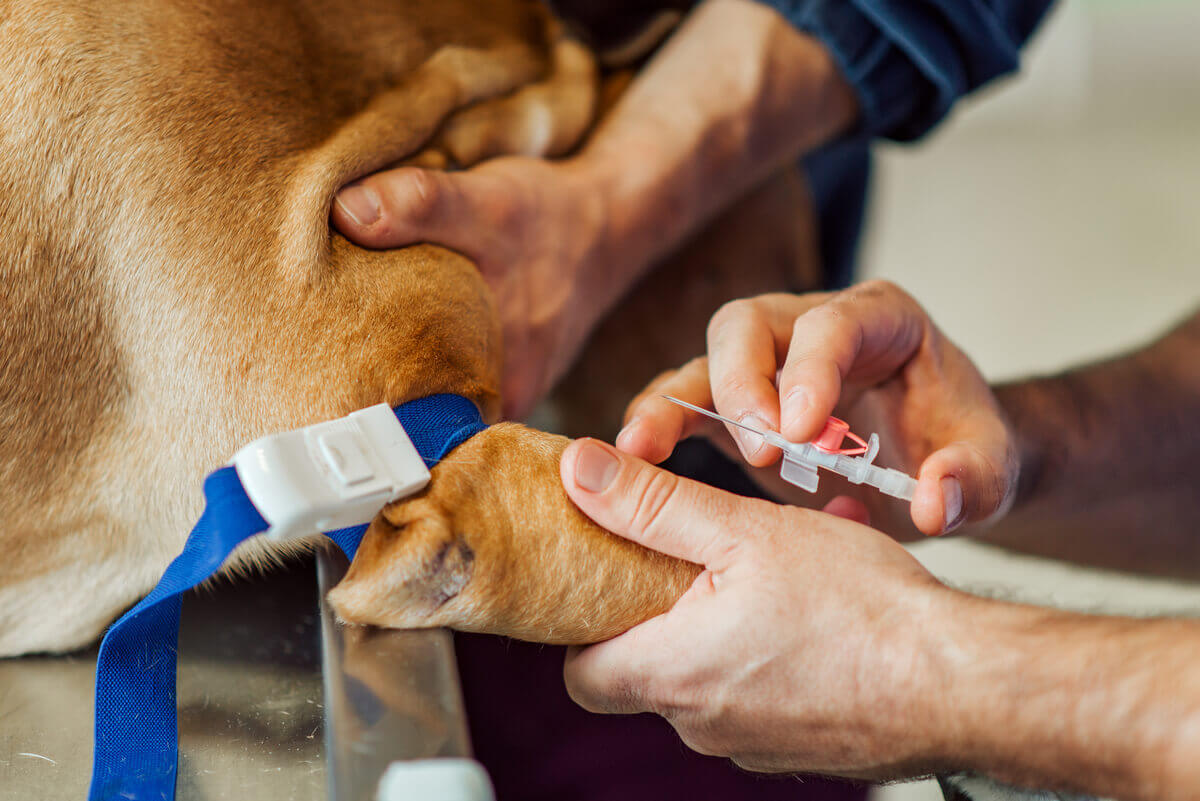Milk Fever in Dogs: How to Identify It and What to Do


Written and verified by the veterinarian and zootechnician Sebastian Ramirez Ocampo
Milk fever in dogs (also called eclampsia) is a metabolic disorder in which calcium levels drop to an unsustainable point for the proper functioning of the body. It can occur both during pregnancy and lactation, and is characterized by tremors, tachycardia, fever, and muscle weakness.
If your pet is about to give birth, or you’d like it to become pregnant, then it’s important that you know in depth the signs, causes, treatment, and prevention of this disorder. This way you’ll be able to provide timely care to your pet. Be sure to read more!
Why does milk fever in dogs occur?
According to an article in the journal, The Veterinary Clinics of North America, milk fever in dogs occurs when blood calcium levels are below 9 mg/dl.
It originates as a result of the high demand for this mineral in the pre- and postpartum stages. That is, during the skeletal ossification of puppies and the production of maternal milk.
Although all dogs raising puppies go through these two processes, inadequate preparation or mismanagement can lead to the depletion of maternal calcium stores.
Although it can occur in any type of dog, those of small breeds (Pinscher, Shih Tzu, Pomeranian, Chihuahua) or those with a predisposition to give birth to large litters (Labrador, Golden Retriever, St. Bernard) are more prone to suffer from it.
Likewise, it occurs more frequently between 10 to 20 days after giving birth, due to the fact that this is the time when the highest peak of milk production occurs.

What are the main causes?
Milk fever in dogs is mainly linked to nutritional and energy deficits in the diet. As stated in a paper in the journal Topics in Companion Animal Medicine, two main causes can be identified.
Calcium supplementation during pregnancy
Many owners may think that providing calcium to their pets during gestation could prevent eclampsia. However, the opposite is true.
This is because the parathyroid gland – which under normal conditions regulates blood calcium levels via parathormone – may atrophy in the face of excessive calcium supplementation.
In more practical terms, what occurs is negative feedback, as the gland stops releasing the hormone when it identifies that no more calcium is needed in the body.
However, when the time comes for lactation and supplementation stops, the parathyroid is unable to produce enough hormone to maintain adequate levels of calcium in the circulation, thus creating hypocalcemia.
An unbalanced diet
During both gestation and lactation, bitches need food that provides the nutrients necessary for their maintenance and that of their puppies. In fact, they require diets that are 5 times their energy requirements under normal conditions.
In addition, according to the article A Quick Reference on Hypocalcemia, vitamin D is essential for proper calcium absorption at an intestinal level.
Therefore, if the food provided lacks a good caloric intake and has an imbalance in minerals and vitamins, mothers won’t be able to recover at the same rate at which they spend their reserves in the nutrition of their newborns.
How can I identify milk fever?
Considering that calcium plays a fundamental role in the transmission of nerve impulses, much of the symptomatology associated with this disorder is neurological in nature. Among the main signs of milk fever in bitches are the following:
- Ataxia or incoordination when walking
- Tremors and spasms
- Muscle weakness
- Body temperature above 40 °C
- Shortness of breath and wheezing
- Agitation and nervousness
- Muscle stiffness
- Tachycardia
- Convulsions
What should I do in this situation?
The first measure is to separate the puppies from their mother. With this, we’ll prevent a greater loss of energy and we’ll reduce the loss of calcium. Subsequently, as our pet’s life is at risk, we should see a veterinarian as soon as possible.
The professional will be in charge of supplying, intravenously, 10% calcium gluconate together with dextrose to restore calcium and energy levels in the organism. It should be emphasized that this procedure should be done slowly, otherwise bradycardia and cardiac arrest may occur.
According to the guidelines from Acute Management of Calcium Disorders, with proper treatment, the symptoms stop within 30 to 60 minutes. However, if the seizures don’t stop, a sedative medication may need to be administered.

On the other hand, once our pet is stabilized, the veterinarian may recommend waiting at least 24 hours before nursing puppies again. During this period, neonates should be sustained with formula milk or wet feeding depending on their age.
Finally, calcium tablets may be prescribed along with calcitriol, which is the active form of vitamin D. This is in order to stabilize and sustain blood calcium levels during the lactation period.
Prevention of milk fever in dogs
To prevent milk fever in our pet, it’s essential to provide quality and well-balanced food from the first weeks of gestation. In addition, we must ensure an adequate water intake, since this element makes up almost 80% of the milk.
After birth, it’s recommended that mothers consume puppy food. Thanks to the mineral and energetic content of this food, metabolic disorders will be prevented during the lactation stage.
Finally, as can be seen, it’s totally counterproductive to use calcium supplements during pregnancy. To be sure that your pet’s pregnancy is going well, the ideal thing is to ask a trained professional for advice.
Milk fever in dogs (also called eclampsia) is a metabolic disorder in which calcium levels drop to an unsustainable point for the proper functioning of the body. It can occur both during pregnancy and lactation, and is characterized by tremors, tachycardia, fever, and muscle weakness.
If your pet is about to give birth, or you’d like it to become pregnant, then it’s important that you know in depth the signs, causes, treatment, and prevention of this disorder. This way you’ll be able to provide timely care to your pet. Be sure to read more!
Why does milk fever in dogs occur?
According to an article in the journal, The Veterinary Clinics of North America, milk fever in dogs occurs when blood calcium levels are below 9 mg/dl.
It originates as a result of the high demand for this mineral in the pre- and postpartum stages. That is, during the skeletal ossification of puppies and the production of maternal milk.
Although all dogs raising puppies go through these two processes, inadequate preparation or mismanagement can lead to the depletion of maternal calcium stores.
Although it can occur in any type of dog, those of small breeds (Pinscher, Shih Tzu, Pomeranian, Chihuahua) or those with a predisposition to give birth to large litters (Labrador, Golden Retriever, St. Bernard) are more prone to suffer from it.
Likewise, it occurs more frequently between 10 to 20 days after giving birth, due to the fact that this is the time when the highest peak of milk production occurs.

What are the main causes?
Milk fever in dogs is mainly linked to nutritional and energy deficits in the diet. As stated in a paper in the journal Topics in Companion Animal Medicine, two main causes can be identified.
Calcium supplementation during pregnancy
Many owners may think that providing calcium to their pets during gestation could prevent eclampsia. However, the opposite is true.
This is because the parathyroid gland – which under normal conditions regulates blood calcium levels via parathormone – may atrophy in the face of excessive calcium supplementation.
In more practical terms, what occurs is negative feedback, as the gland stops releasing the hormone when it identifies that no more calcium is needed in the body.
However, when the time comes for lactation and supplementation stops, the parathyroid is unable to produce enough hormone to maintain adequate levels of calcium in the circulation, thus creating hypocalcemia.
An unbalanced diet
During both gestation and lactation, bitches need food that provides the nutrients necessary for their maintenance and that of their puppies. In fact, they require diets that are 5 times their energy requirements under normal conditions.
In addition, according to the article A Quick Reference on Hypocalcemia, vitamin D is essential for proper calcium absorption at an intestinal level.
Therefore, if the food provided lacks a good caloric intake and has an imbalance in minerals and vitamins, mothers won’t be able to recover at the same rate at which they spend their reserves in the nutrition of their newborns.
How can I identify milk fever?
Considering that calcium plays a fundamental role in the transmission of nerve impulses, much of the symptomatology associated with this disorder is neurological in nature. Among the main signs of milk fever in bitches are the following:
- Ataxia or incoordination when walking
- Tremors and spasms
- Muscle weakness
- Body temperature above 40 °C
- Shortness of breath and wheezing
- Agitation and nervousness
- Muscle stiffness
- Tachycardia
- Convulsions
What should I do in this situation?
The first measure is to separate the puppies from their mother. With this, we’ll prevent a greater loss of energy and we’ll reduce the loss of calcium. Subsequently, as our pet’s life is at risk, we should see a veterinarian as soon as possible.
The professional will be in charge of supplying, intravenously, 10% calcium gluconate together with dextrose to restore calcium and energy levels in the organism. It should be emphasized that this procedure should be done slowly, otherwise bradycardia and cardiac arrest may occur.
According to the guidelines from Acute Management of Calcium Disorders, with proper treatment, the symptoms stop within 30 to 60 minutes. However, if the seizures don’t stop, a sedative medication may need to be administered.

On the other hand, once our pet is stabilized, the veterinarian may recommend waiting at least 24 hours before nursing puppies again. During this period, neonates should be sustained with formula milk or wet feeding depending on their age.
Finally, calcium tablets may be prescribed along with calcitriol, which is the active form of vitamin D. This is in order to stabilize and sustain blood calcium levels during the lactation period.
Prevention of milk fever in dogs
To prevent milk fever in our pet, it’s essential to provide quality and well-balanced food from the first weeks of gestation. In addition, we must ensure an adequate water intake, since this element makes up almost 80% of the milk.
After birth, it’s recommended that mothers consume puppy food. Thanks to the mineral and energetic content of this food, metabolic disorders will be prevented during the lactation stage.
Finally, as can be seen, it’s totally counterproductive to use calcium supplements during pregnancy. To be sure that your pet’s pregnancy is going well, the ideal thing is to ask a trained professional for advice.
All cited sources were thoroughly reviewed by our team to ensure their quality, reliability, currency, and validity. The bibliography of this article was considered reliable and of academic or scientific accuracy.
- Coady, M., Fletcher, D. J., & Goggs, R. (2019). Severity of Ionized Hypercalcemia and Hypocalcemia Is Associated With Etiology in Dogs and Cats. Frontiers in Veterinary Science, 6, 276. https://www.ncbi.nlm.nih.gov/pmc/articles/PMC6714612/
- Davidson, A. P. (2012). Reproductive causes of hypocalcemia. Topics in companion animal medicine, 27(4), 165–166. https://www.sciencedirect.com/science/article/abs/pii/S193897361200061X?via%3Dihub
- De Brito Galvão, J. F., Schenck, P. A., & Chew, D. J. (2017). A Quick Reference on Hypocalcemia. The Veterinary clinics of North America. Small Animal Practice, 47(2), 249–256. https://www.sciencedirect.com/science/article/abs/pii/S0195561616301358?via%3Dihub
- Gonzales, K. (2018). Periparturient Diseases in the Dam. The Veterinary clinics of North America. Small Animal Practice, 48(4), 663–681. https://www.sciencedirect.com/science/article/abs/pii/S0195561618300214?via%3Dihub
- Groman, R. P. (2012). Acute management of calcium disorders. Topics in Companion Animal Medicine, 27(4), 167–171. https://www.sciencedirect.com/science/article/abs/pii/S1938973612000864?via%3Dihub
- Rishniw, M. (2020). Eclampsia in dogs: What’s in a name? Veterinary Journal (London, England : 1997), 257, 105437. https://www.sciencedirect.com/science/article/abs/pii/S1090023320300149?via%3Dihub
- Stockman, J., Villaverde, C., & Corbee, R. J. (2021). Calcium, Phosphorus, and Vitamin D in Dogs and Cats: Beyond the Bones. The Veterinary Clinics of North America. Small animal practice, 51(3), 623–634. https://www.sciencedirect.com/science/article/pii/S0195561621000139?via%3Dihub
This text is provided for informational purposes only and does not replace consultation with a professional. If in doubt, consult your specialist.








